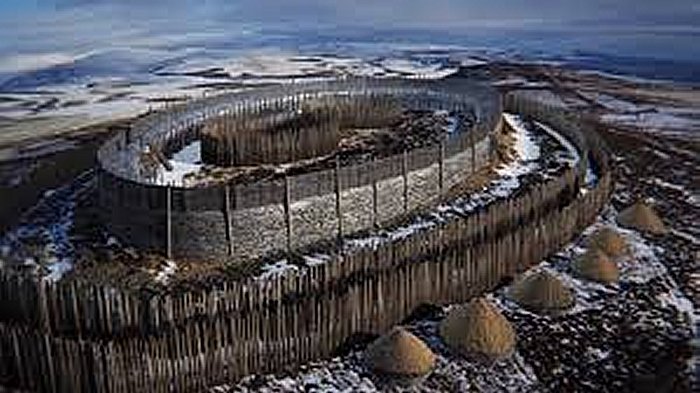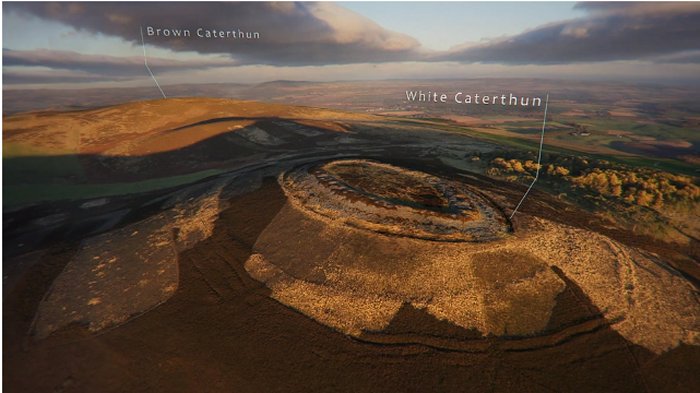Stunning Reconstruction Of Caterthun Iron Age Forts In The Grampian Mountains, Scotland
A. Sutherland - AncientPages.com - By combining archaeological research with aerial photography and creative visualization technologies, a talented filmmaker has produced stunning recreation of Caterthun Iron Age Forts in the Grampian Mountains, in Angus, Scotland.
These images and video give us a unique and fascinating look into the past.
The White and Brown Caterthuns are two massive Iron Age hill-forts that were constructed with various building methods.
These impressive forts are among the best-preserved forts in Scotland and their names are very appropriate. The White Caterthun is crowned by a mass of pale stone, while the Brown Caterthun lies beneath a dark mantle of heather. The two forts are only 2.6 km (1,5 m) apart, but they are very different and unfortunately there is no dating evidence for either.
The White Caterthun fort is considered to be one impressive ruined wall in Britain. Surrounded by a massive stone wall that was initially as much as 40 feet thick, this prehistoric fort covers an area of about 550 by 220 feet in circumference.
The fort was constructed in the last few centuries B.C. and reveals how skilled the ancient builders in Scotland were. Both these forts are are among the best-preserved forts in Scotland.
The White Caterthun has a massive spread of stones, tumbled from two concentric walls, which in their heyday must have presented a stunning sight. The inner wall alone was some 12 m thick and several metres high, enclosing an area of about 2 acres (.7 hectares). Now the combined boulder mass is spread over about 30 m (100 ft).
See also:
10 Reconstructions Of Ancient Cities, Monuments And Sacred Sites
Picts: Facts And History About Mysterious People Of Northern Scotland
History Of Jarlshof – Thousands Of Years Of History With Traces Of Picts, Vikings And Scots
A mile to the Northeast, we can find the Brown Caterthun Iron Age fort. It is slightly smaller, but it is also a very intriguing ancient construction. Archaeologists believe that the Brown Caterthun fort was used either in defensive or ritual purpose. When it was built is unclear, but scientists estimate its construction range from 3,000 B.C to 500 B.C.
Who built the fort is also uncertain, but most likely it was raised by the Picts.
Kieran Baxter, filmmaker and PhD student at Scotland's Dundee University specializes in merging aerial photography with digital visualization. With help of archaeological research and visual FX, Baxter reconstructed the two Iron Age forts so we can get a glimpse into the ancient past.
On his website, Baxter writes that the aim of his PhD project is to “to better understand how an emerging array of aerial platforms and digital image processing techniques can be used creatively to enhance public engagement with built heritage and it's associated archaeological narrative.”
The results of his study and work are amazing and his film won The Doctoral Award at the AHRC Research in Film Awards 2016.
Written by – A. Sutherland - AncientPages.com Senior Staff Writer
Copyright © AncientPages.com All rights reserved. This material may not be published, broadcast, rewritten or redistributed in whole or part without the express written permission of AncientPages.com
Expand for referencesMore From Ancient Pages
-
 New DNA Evidence Rewrites Ancient History Of Pompeii
DNA | Nov 8, 2024
New DNA Evidence Rewrites Ancient History Of Pompeii
DNA | Nov 8, 2024 -
 Mysterious 3,000-Year-Old Underwater Urartu Castle Discovered
Archaeology | Nov 22, 2017
Mysterious 3,000-Year-Old Underwater Urartu Castle Discovered
Archaeology | Nov 22, 2017 -
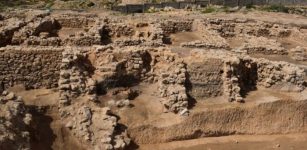 Ancient Greco-Roman Amphora Workshop Discovered In Alexandria, Egypt
Archaeology | Apr 17, 2022
Ancient Greco-Roman Amphora Workshop Discovered In Alexandria, Egypt
Archaeology | Apr 17, 2022 -
 On This Day In History: The Battle of Mortimer’s Cross – On Feb 2, 1461
News | Feb 2, 2017
On This Day In History: The Battle of Mortimer’s Cross – On Feb 2, 1461
News | Feb 2, 2017 -
 Priam’s Treasure – Authentic Trove From Homeric Troy Or Deception?
Artifacts | Jun 11, 2021
Priam’s Treasure – Authentic Trove From Homeric Troy Or Deception?
Artifacts | Jun 11, 2021 -
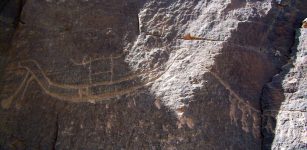 Pre-Pharaonic Petroglyphs Used To Study Egyptian Cult Of The Gods
Archaeology | Mar 15, 2023
Pre-Pharaonic Petroglyphs Used To Study Egyptian Cult Of The Gods
Archaeology | Mar 15, 2023 -
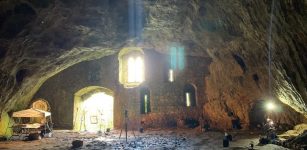 Cave Hidden Under Pembroke Castle in Wales Could Hold Secrets Dating Back 10,000 Years
Archaeology | Jul 16, 2022
Cave Hidden Under Pembroke Castle in Wales Could Hold Secrets Dating Back 10,000 Years
Archaeology | Jul 16, 2022 -
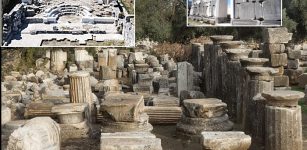 Restorations At Stratonicea Ancient City Of Gladiators In Turkish Muğla Province
Archaeology | May 10, 2023
Restorations At Stratonicea Ancient City Of Gladiators In Turkish Muğla Province
Archaeology | May 10, 2023 -
 Ancient Riddle Solved – Why Was Roman Concrete So Durable?
Archaeology | Jan 7, 2023
Ancient Riddle Solved – Why Was Roman Concrete So Durable?
Archaeology | Jan 7, 2023 -
 Mnemosyne: Powerful Greek Goddess Of Memory, Bridge Between The Past And The Future
Featured Stories | Aug 2, 2021
Mnemosyne: Powerful Greek Goddess Of Memory, Bridge Between The Past And The Future
Featured Stories | Aug 2, 2021 -
 INAH Archaeologists Focus On Ancient Religious And Ceremonial Site Of Teteles Of Avila Castle, Puebla, Mexico
Archaeology | Nov 7, 2024
INAH Archaeologists Focus On Ancient Religious And Ceremonial Site Of Teteles Of Avila Castle, Puebla, Mexico
Archaeology | Nov 7, 2024 -
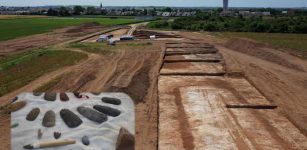 Ancient DNA Unravels The Mystery Of Huge 6,500-Year-Old Cemetery And The Tomb Of A ‘Masculine Woman’ In Normandy, France
Archaeology | May 5, 2022
Ancient DNA Unravels The Mystery Of Huge 6,500-Year-Old Cemetery And The Tomb Of A ‘Masculine Woman’ In Normandy, France
Archaeology | May 5, 2022 -
 Secrets Of Neanderthals’ 130,000-Year-Old Carved Bear Bone Found In The Carpathian Mountains
Archaeology | May 24, 2024
Secrets Of Neanderthals’ 130,000-Year-Old Carved Bear Bone Found In The Carpathian Mountains
Archaeology | May 24, 2024 -
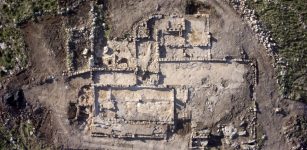 Impressive 2,700-Year-Old Farmhouse And 1,500-Year-Old Monastery Uncovered In Rosh Ha-‘Ayin
Archaeology | Dec 30, 2015
Impressive 2,700-Year-Old Farmhouse And 1,500-Year-Old Monastery Uncovered In Rosh Ha-‘Ayin
Archaeology | Dec 30, 2015 -
 On This Day In History: Battle Of Durnstein Was Fought On The River Danube – On Nov 11, 1805
History | Nov 11, 2016
On This Day In History: Battle Of Durnstein Was Fought On The River Danube – On Nov 11, 1805
History | Nov 11, 2016 -
 Draugr – Vikings Feared This Ugly Living Dead With Prophetic Visions
Featured Stories | May 24, 2020
Draugr – Vikings Feared This Ugly Living Dead With Prophetic Visions
Featured Stories | May 24, 2020 -
 Cheomseongdae “Star-Gazing Tower” Is The Oldest Observatory In East Asia
Featured Stories | Mar 31, 2021
Cheomseongdae “Star-Gazing Tower” Is The Oldest Observatory In East Asia
Featured Stories | Mar 31, 2021 -
 Ancient Manuscripts About Sea Monsters Solve An Ocean Mystery
News | Mar 1, 2023
Ancient Manuscripts About Sea Monsters Solve An Ocean Mystery
News | Mar 1, 2023 -
 Herne The Hunter – The Horned God And Lord Of The Forest In British Mythology
Featured Stories | Jan 12, 2016
Herne The Hunter – The Horned God And Lord Of The Forest In British Mythology
Featured Stories | Jan 12, 2016 -
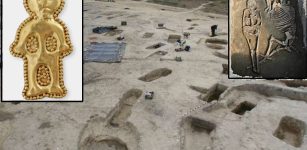 Ancient DNA And Historical Context Were Used To Explain Kinship, Social Practices Of Avar Society
Archaeology | Apr 25, 2024
Ancient DNA And Historical Context Were Used To Explain Kinship, Social Practices Of Avar Society
Archaeology | Apr 25, 2024


